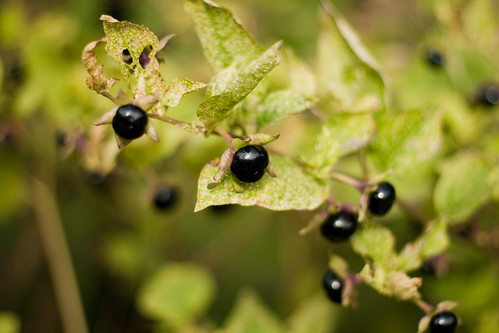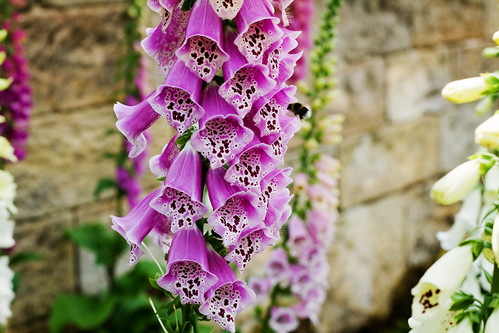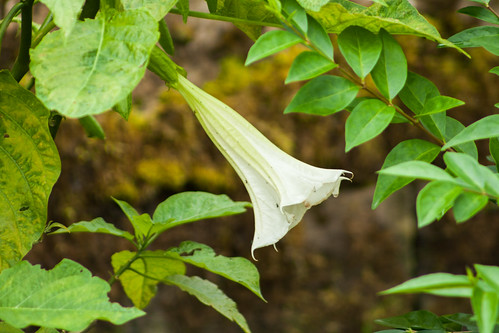The folklore of flowers proves an expansive subject, both terrifying and interesting in equal measure. Much like the world of trees and plants at the best of times. They follow their own cycles, often independent of human intervention. They’ll often grow in seemingly inhospitable environments. They’re living creatures, but they’re rooted to the spot. They are hardy or delicate, wild or cultivated.
They can also be incredibly dangerous.
Poisonous plants are a particular interest of mine and I like to call it toxic botany. One of my favourite places to visit is the Poison Garden at the Alnwick Garden where some of the plants are even kept under lock and key. Others, like henbane, produce such a noxious smell that you don’t even want to go near them.
At the Poison Garden, knowledgeable guides lead small bands of visitors among the beds. They point out the different varieties and relate tales associated with the folklore of flowers. Some of them are common plants you’d find in your garden, others are more difficult to cultivate. If you’re interested in the development of poison gardens, I have an article about them on the Folklore Thursday website.
But here are three of my favourite specimens, as we delve into the folklore of flowers!
Remember, none of this post constitutes medical advice, and the information presented is for entertainment purposes only.
Deadly Nightshade (Atropa Belladonna)
Atropa belladonna, also known as deadly nightshade, is extremely poisonous! It comes from the Solanaceae family…along with peppers, aubergines, tomatoes and potatoes! It’s also known as banewort, deadly dwale, Devil’s cherries, or death’s herb (Baker 2011: 107).

Its name, belladonna, comes from the Italian, ‘beautiful lady’. There was a belief that the plant would create visions of a beautiful temptress leading to its name (The Alnwick Garden: 8).
There is another explanation. In bygone days, Venetian women believed that dilated pupils made them more attractive. Therefore they dropped belladonna into their eyes to dilate the pupils. It’s not as mad as it sounds. The pupils naturally dilate when the person is aroused, so it would serve to make the ladies look more interested than they perhaps were. Quite handy if you’re after a husband.
Its name, Atropa, comes from Atropos, the third of the Greek Fates. It was her job to cut the thread of life after it had been measured out by her two sisters. It was also sacred to Bellona, a Roman war goddess. Belladonna is very heavily associated with death.
Deadly Nightshade and the Devil
Deadly nightshade was known as the plant of the Devil in Bohemia. If you released a black hen on May Eve (Walpurgisnacht), he would chase it and leave the nightshade unguarded. I’m assuming this was recorded because it made this the ideal time to harvest the plant (Baker 2011: 108). Parents told their children that those caught picking the berries would meet the Devil face to face. They needed a way to discourage their children from eating the berries; they’re apparently quite sweet. They’re also highly toxic, so keep away from the entire plant. All of it is extremely dangerous.

That said, people apparently made it into a collar for their cattle to avert the Evil Eye. You could also lift an enchantment from a person by putting a wreath of nightshade on their head (Baker 2011: 108).
Witchcraft and Early Medicine
Along with opium poppy and other plants, belladonna was believed to make up the ‘flying ointment’ used by witches. Commentators thought the ointment helped the witches to fly to their gatherings, but it’s more likely that a combination of the plants caused hallucinations. This helps to explain why some people used it in spells to “induce second sight” (Baker 2011: 107).
According to Amy Stewart, nightshade was also mixed with hemlock, mandrake, opium and henbane to make an early surgical anaesthetic (2010: 33). She also notes that atropine, one of the compounds from the plant was used as an antidote to nerve gas poisoning (Stewart 2010: 33). Apparently, atropine was also used as an antidote to foxglove poisoning (Gillam 2008: 10)!
Foxglove (Digitalis purpurea)
The foxglove is also known as fairy thimbles, witches’ gloves, and dead man’s bells. According to folklore, if you hear the bells ring, you’ll die soon (Baker 2011: 61). They are among the prettiest of the poisonous plants yet it’s also medicinally very useful. English doctor Will Withering discovered the plant’s properties from a herbalist. He originally developed a cure for dropsy using digitalis, but now it’s also used in heart medicine (Laws 2010: 64).
Fred Gilliam explains that for Culpeper, the plant could be used to treat the ‘King’s Evil’ (scrofula), or to clean sores. It was also called throatwort for its use in treating throat infections. But do not consume any part of the plant yourself (2008: 30).
Foxes and Fairies
The plant is toxic, but planting it in the garden may grant your house protection. It is also said to attract fairies and according to legend, the white spots inside each bell are marks left by fairies. But don’t pick the foxglove and bring it inside, as it’ll annoy the fairies. This made it an unlucky plant to have indoors, though Margaret Baker also notes it was unlucky to have on board ship (2011: 61).

Leave it outside where it’ll be a favourite spot for bees!
In some sources, the name ‘fox glove’ was just a misspelling of ‘folk’s glove’. In others, the name came from the fact that fairies apparently taught foxes to ring the bells, warning other foxes of hunters in the area (Binney 2018: 31). Another tale claimed that the fairies gave the flowers to the foxes to wear over their paws so the hens in the hen house wouldn’t hear them coming (Binney 2018: 31)!
Its legends extend beyond fairies. According to Roman mythology, Juno grew tired of Jupiter conceiving children with other women – but not her. The goddess Flora touched a foxglove to her belly and breasts, and Juno conceived the god, Mars.
In the language of flowers, the foxglove represents insincerity (Binney 2018: 31). That’s because it hides a poisonous heart behind a pretty facade.
Angel’s Trumpet (Brugmansia suaveolens)
Angel’s trumpet is another member of the Solanaceae family. It’s toxic, but its unpleasant taste makes accidental poisoning rare. Some people make tea from the seeds. This dodgy practice is what usually causes poisonings. It contains a lot of scopolamine, which gives it psychoactive properties.
But this post is about the folklore of flowers! At one time Brugmansia was allegedly a favoured murder weapon. Professional assassins thought it caused a lack of movement, or induced sleep, in victims (The Alnwick Garden: 9). Whether this ever worked isn’t clear since most reports say the plant’s chemicals cause agitation.

In more magical terms, Brugmansia can be used to encourage communication with the dead. It’s a little more dodgy than using a Ouija board. Its name is also associated with a snippet of folklore about the planet. Apparently, if you sleep under a brugmansia plant, you can’t wake up because the angels will come for you (McIndoe 2014). It’s more likely the effects of its fragrance that create a problem.
They are related to deadly nightshade and black henbane. That’s one fairly poisonous family tree! They are beautiful though, and there’s something very magical about them. I often wonder if the trumpets sound in the dead of night.
They’re often confused with Devil’s trumpets, which are actually part of the Datura species. They are related to Brugmansia, but they are different plants. The easiest way to tell the difference is Devil’s trumpets bloom upwards, while Angel’s trumpets hang down from the plant.
The study of the folklore of flowers reveals some interesting and unusual stories.
It’s debatable how true any of them are but a lot of the stories around these plants are telling. Embedded in many of them are nuggets of truth around the toxicity of the plants.
And what better way to warn someone away from something dangerous! Humans respond to stories and fear, and some of the stories about plants are tremendous!
Have you got any of these in your garden? Let me know in the comments!
References
Baker, Margaret (2011 [1969]), Discovering the Folklore of Plants, third edition, Boxley, Oxford: Shire Classics (aff link).
Binney, Ruth (2018), Plant Lore and Legend, Hassocks: Rydon (aff link).
Gillam, Fred (2008), Poisonous Plants in Great Britain, Glastonbury: Wooden Books (aff link).
Laws, Bill (2010), Fifty Plants That Changed the Course of History, Hove: Quid Publishing (aff link).
McIndoe, Andy (2014), ‘What to plant for a Mediterranean look’, Learning With Experts, https://www.learningwithexperts.com/gardening/blog/what-to-plant-for-a-mediterranean-look.
Stewart, Amy (2010), Wicked Plants: The Weed That Killed Lincoln’s Mother & Other Botanical Atrocities, Portland, OR: Timber Press (aff link).
The Alnwick Garden (no date), The Poison Garden souvenir guide, Alnwick, Northumberland: The Alnwick Garden.
Nutty about folklore and want more?
Add your email below and get these posts in your inbox every week.
You'll also get my 5-step guide to protecting your home using folklore!








Wicked post. Really enjoyed this. I did know Belladonna (or however you spell it) was poisonous but I didn’t know about the others. I used to have fox gloves in our garden, I had no idea they were poisonous. I’d love to know what the consequences are of ingesting these plants. You also just gave me a wicked cool idea for some research I need to do 😀 <3. WE might have to try and visit those gardens when we drive up to scotland this summer.
I can recommend some good books if you want!
Id always thought nightshade was poisonous yes..i worked at the hospital at lion country and had to hunt 300 acres of Florida turrain. I have magical land. I did however confuse belladonna with Angel trumpets. The shape of the flower before it buds i guess and being in the same family..many of mine are hybridized. I have even a cosmo that cross bred with a marigolds! It make the world’s biggedt marigolds!! But the body of a taller cosmo. My angel trumpets grow wild. My grandfather was from a reservation . Hes Blackfoot. Like belladonna..he did use the angel trumpets. I would never recreate what he had done through generations. But like belladonna the tea was in thr dose he was able to make it..non psycho tropic and beneficial to the gi trouble i had all my life. It relieved the pain. But i never learned how. There is alot of nightshade. Too much for my animals unfortunately. Foxglove takes here well too as do roses. Roses grow as tall as my home ( in Florida anything tall is an oddity) my angel trumpets are as tall as my home and beautifully cover one full side of my acreage. Foxglove is choosier. I try to transplant the ones in the pasture but cant always miss with the tractor? ..it was already here when i bought this place. I love it. My angel trumpets havs also been taken samples from for medical use in the medical marijuana industry hence the chemists do feel there are healing properties that can be EXTRACTED with an ethanol process and used in micro amounts. But ill be sure to send over the nightshade as well. Our chemists look for what heals in those poisons. After all belladonna is in almost every chrohns patients medical cabinet mixed with atropine or opiate! Can you imagine how much better a mixture with non psychotropic delta 8 thc that is geared with our receptors for gi issues rather than opiates would be? Hoping all gi patients one day have SAFE acces to these one made into medicine!!!
The head of the California farms said my specimens were amazing ( Tony the head of Blue River Extracts) i should send photos. He said especially the hybrids were beautiful. He thought i did it myself and did some genetic work. He was so surprised i dont even tend them he took photos to send to his farms and one in Miami.
Have you got any photos online?
Absolutely! Have you come across the Bane Folk website before?
I’ve always loved Angel’s Trumpets. They have a beautiful scent. I didn’t know about their poisonous characteristics though. We go pass a massive tree with them on the way to school with one of my sons and we always look at the flowers. Thank you for referencing that book. I’m really interested in the Gothic side of nature.
Hi Icy
This is such a fascinating topic!
Sacha Black my friend had Fox Glove in her garden but uprooted it when her kid started crawling.
What books would you recommend, Icy?
My favourites are Wicked Plants: The Weed That Killed Lincoln’s Mother and Other Botanical Atrocities, Discovering the Folklore of Plants, Plant Lore and Legend: The Wisdom and Wonder of Plants and Flowers Revealed and Fifty Plants That Changed the Course of History!
I’ve got all three actually. And no, sadly Brugmansia doesn’t sound in the middle of the night, But it is a night scented plant, and puts off its scent in the evening, making it perfect for a moon garden. When the whole tree is in bloom you can smell it from some distance even, and it’s very intoxicating.
I love night-scented flowers! I’ll have to put some in the garden.
I love in New Orleans,La.USA and have both Angels Trumpet and Devils Trumpet in my yard. I love to read about the origins and uses of “weed plants” . I have some wonderful photos of them in all their dark glory of you’d like to see. I didn’t know that Devils Trumpet was a class B drug! Learn something new everyday!
Cheers,
Becky in NOLa
I’d love to see! 😀
I have Very Much Enjoyed this on Poison Flowers!! Thank You!!😊🌻🌺🌼👏
What a fun article! I especially like plants that are only poisonous at certain points in the growing cycle. Otherwise, they’re fine. Timing is everything!
It really is!
My pleasure!
Thank you. I enjoyed this!
My pleasure! The folklore of plants is probably my favourite part.